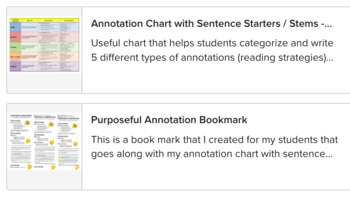Purposeful Annotation - Printable Chart & Bookmark
- Zip
Products in this Bundle (2)
Description
Useful chart and bookmark bundle that can be printed out, laminated, or shared with students electronically and then used to support students' close reading of any text.
The chart helps students categorize and write 5 different types of annotations (reading strategies) for any class. They are clarify, question, connect, infer & predict, and evaluate annotations. The chart explains to students what the annotation is (a definition), how to do it, and how to start it (sentence starters). The book mark includes those annotations and also breaks them up into three categories: before, during and after reading and includes a definition and description of 5 different types of annotations students can write when reading complex texts. See individual product descriptions for more details and previews!


